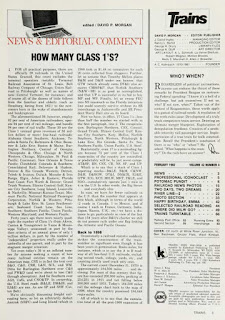 |
Challenger 3985 charges south with the Circus Train toward Denver September 28, 2010
Photo: John H. Hill |
While fans of the Union Pacific come down from the high of their inaugural season of Big Boy 4014, it cannot be all good news coming from Cheyenne, the heart of UP Steam just over the border in Wyoming. UP announced their intention to retire Challenger-type 3985, the other articulated steam locomotive inhabiting the UP Steam shops.
Built in July 1943 by the American Locomotive Company (ALCO) and retired by UP in 1962, the 4-6-6-4 Challenger was restored as a volunteer-initiated project back in 1979. Returned to service with UP in April 1981 and converted to oil in 1990, it held the title of world's largest operating steam locomotive until the return of Big Boy 4014 in May 2019, although its last active run was in October 2010.
Why not keep her running? Apart from UP Steam having its hands full with 844 and 4014, the other two big steam engines, 3985 was looking at a long and extensive restoration.
According to Kevin P. Keefe, "Such are the consequences of running the wheels off it," since its return to service. Weighing this against the decreased demand, there's just not that much reason to keep her active.
Nonetheless, any time a steamer goes silent, it's a sad day for the railfan. Like Keefe, I feel a need to honor the Challenger. Keefe says,
With all due respect to N&W 2-6-6-4 No. 1218 and its brethren, I can’t see how UP’s 4-6-6-4s cannot be considered the world’s most successful simple articulateds, given their sterling dual-service operational record on UP, not to mention how they begat near-carbon-copies on Clinchfield, D&H, Northern Pacific, and SP&S.
Those near-carbon-copies on Clinchfield? They were delivered to the Rio Grande as their L-97 class, numbered 3800-3805 in May and June 1943. They served until 1947 when the D&RGW sold them to the Clinchfield, renumbering them 670-675.
1 The Rio Grande didn't actually want the Challengers, either. They wanted 5 more Baldwin 4-6-6-4s (Class L-105), but the War Production board assigned the Alcos by tacking them on to the Union Pacific's order. The Rio Grande opted not to buy them, instead leasing them from the Defense Plant Corporation. They were, in 1943, the last new steam engines the Rio Grande ever received.
2 So, for many born after 1950, the Challenger a way for us to witness, perhaps unwittingly, the Rio Grande's main line steam in the post-war years.
Let us remember perhaps the most important aspect of the Challenger's story: the
volunteer initiative to restore it to service. Few at Union Pacific saw the advantages of full restoration except these volunteers. The uses of old steamers was limited to park centerpieces to bolster civic pride. The public perception was that railroads were profit-shy and mired in regulation and bureaucracy. Additionally, eight years earlier, Amtrak had removed the last point of contact of the Union Pacific with the American public. Aside from delaying drivers at grade crossings, there was no reminder to the public of the services the railroad provided to the public. It's not a huge stretch to say that without the volunteers stepping forward, Union Pacific's public image would be far less than it is today.
While an ending, this is not necessarily the utter end for 3985. Challenger will sit in the Cheyenne roundhouse alongside her stablemates for the foreseeable future. It costs very little to preserve a steam locomotive already sheltered from the elements. Perchance it might cost little more if a slow, paced restoration was quietly undertaken? Perhaps in another 20 years, we may see the need for
three steam locomotives in the steam program. It's always a possibility, especially if UP continues using steam to power its public relations.⚒
References
1 Locomotives of the Rio Grande by the Colorado Railroad Museum p.59
2 Rio Grande: To the Pacific! by Robert LaMassena p.160
UP Steam #3985 Fact Sheet
Wikipedia

















